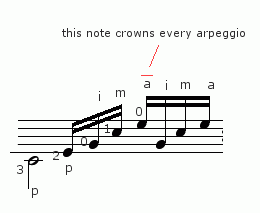
Bach, "Prelude 1 from Well Tempered Clavier" (TAB)
Transcription and Fingering: Renato Bellucci
Solo Instrumental Works
Instrumentation: harpsichord
Original Key: C
Year: 1722
Renato Bellucci Plays "Prelude 1 WTC""
Add to playlist
Prelude 1 from Well Tempered Clavier: J.S.Bach, Renato Bellucci. Asuncion, May 21, 2013
Johannes Sebastian Bach
Bach uses the simplest musical tools to create greatness. Hid dominion over the musical idiom allowed him to make the greatest musical phrases using an otherwise meaningless arpeggio. The main melody is embedded in the arpeggio and the technique of repetition is used to help the listener grasp the different modulations better.
It was completed at Cöthen in 1722 (Part II of the well tempered clavier preludes and fugues was completed at Leipzig around 1740) The subject in Bach's clavier figures is clearly defined at the beginning and the Master takes us into a glorious trip. Once again, the listener feels that every note is exactly where it should be and the architecture is perfect.
Gounod's 19th century adaptation of Prelude 1 has become his most popular song: Ave Maria
Well tempered is a statement made towards the relatively new world of keyboard instruments. Whereas tempered means in tune, versus the non tempered instruments like the violin that had no fixed tuning (by means of frets or keys).
To allow for more music in one staff, I use the repetition bars at the end of each arpeggio.
Staff and Video 1
Analysis:
Play each arpeggio module twice.
A little emphasis should be placed on the highest note crowning each arpeggio.
Video 1
The continuation of this masterclass is in the members area, become a member today.
 Back to Top
Back to Top



